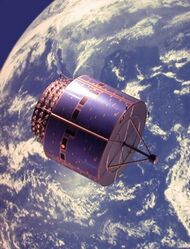Engineering:Synchronous Meteorological Satellite
The Synchronous Meteorological Satellite (SMS) program, was a program where NASA developed two weather satellites; which were placed into geosynchronous orbit.
History
SMS-1 was launched May 17, 1974 and SMS-2 was launched February 6, 1975.[1][2] Both satellites were carried to orbit by Delta 2914 rockets.[3] The program was initiated after the successes achieved by the Applications Technology Satellite (ATS) research satellites, which demonstrated the feasibility of using satellites in geosynchronous orbit for meteorology. The Geostationary Operational Environmental Satellite (GOES) program, which now supports weather forecasting, severe storm tracking, and meteorology research in the United States, followed immediately after the SMS program; the GOES 1 satellite was initially designated SMS-C.[4] SMS-1 and SMS-2; and GOES-1, GOES-2, and GOES-3; were essentially identical.[5]
List of SMS satellites
| Designation | Launch Date/Time (UTC) | Rocket | Launch Site | Longitude | First Image | Status | Retirement | Remarks | |
|---|---|---|---|---|---|---|---|---|---|
| Launch | Operational | ||||||||
SMS series satellites | |||||||||
| SMS-A | SMS-1 | May 17, 1974 | Delta 2914 | ||||||
| SMS-B | SMS-2 | February 6, 1975 | Delta 2914 | ||||||
SMS-derived satellites | |||||||||
| SMS-C GOES-A |
GOES 1 | October 16, 1975, 22:40 | Delta 2914 | Cape Canaveral Air Force Station LC-17A | October 25, 1975 | Retired | March 7, 1985[6] | ||
| SMS-D GOES-B |
GOES 2 | June 16, 1977, 10:51 | Delta 2914 | Cape Canaveral Air Force Station LC-17B | 60°W | Retired | 1993[7] | Reactivated as comsat in 1995,[7] finally deactivated in May 2001 | |
| SMS-E GOES-C |
GOES 3 | June 16, 1978, 10:49 | Delta 2914 | Cape Canaveral Air Force Station LC-17B | Retired | 1993[8] | Reactivated as comsat in 1995,[8] was decommissioned 29 June 2016 | ||
References
- ↑ "SMS 1 - NSSDC ID: 1974-033A". NASA NSSDC. https://nssdc.gsfc.nasa.gov/nmc/spacecraft/display.action?id=1974-033A.
- ↑ "SMS 2 - NSSDC ID: 1975-011A". NASA NSSDC. https://nssdc.gsfc.nasa.gov/nmc/spacecraft/display.action?id=1975-011A.
- ↑ Jonathan McDowell. "Launch Log". http://planet4589.org/space/log/launchlog.txt.
- ↑ "GOES 1 - NSSDC ID: 1975-100A". NASA NSSDC. https://nssdc.gsfc.nasa.gov/nmc/spacecraft/display.action?id=1975-100A.
- ↑ "SMS". NASA SMD. http://nasascience.nasa.gov/missions/sms/.
- ↑ "GOES-1". ESE 40th Anniversary. NASA. 1999-05-12. http://goes.gsfc.nasa.gov/text/history/goes/goes1.html. Retrieved 2009-06-23.
- ↑ 7.0 7.1 "GOES-2". ESE 40th Anniversary. NASA. 1999-04-22. http://goes.gsfc.nasa.gov/text/history/goes/goes2.html. Retrieved 2009-06-23.
- ↑ 8.0 8.1 "GOES-3". ESE 40th Anniversary. NASA. 1999-04-22. http://goes.gsfc.nasa.gov/text/history/goes/goes3.html. Retrieved 2009-06-23.
 |


